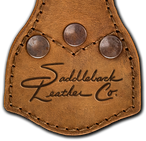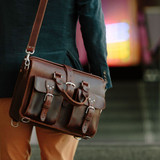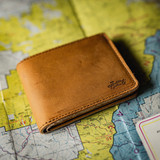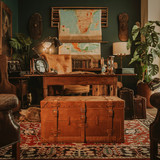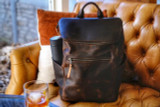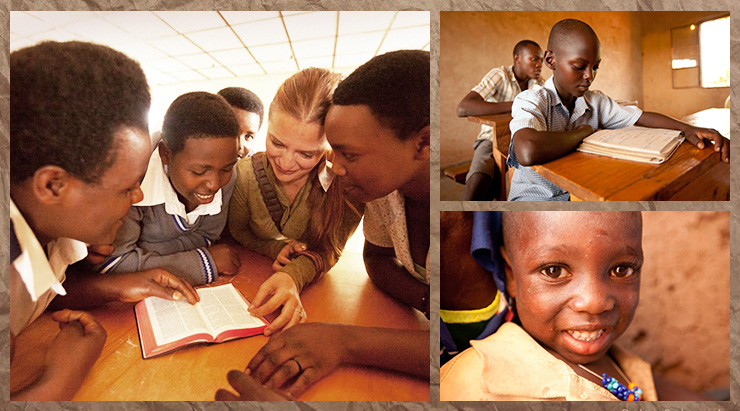All About Leather
The Common Man’s Guide to Understanding Quality Leather
Imagine a cow is killed and skinned. Go ahead, imagine that for a few seconds. The skin that came off is pretty thick so the tannery splits it in half, the top from the bottom and now they have two hides to sell. The top layer of the hide has the FULL amount of the super tough, dense and strong fibers (GRAIN) that give leather its reputation for strength and durability. That top half of the hide is called FULL GRAIN. The bottom half looks good but is not nearly as strong.
Full Grain vs Top Grain Leather: What's the Difference?
Grain is to leather what shingles are to a roof. Imagine you pay for someone to put a new roof on your house and they take off the shingles and then replace them by painting on new shingles. That would be crazy. There would be sun damage, the wood would dry up and crack and the water would get in easily. Well, it's the same with leather without grain.
If they shave or sand off a tad bit of the grain, enough to get rid of the natural scars and blemishes, then that's called TOP GRAIN leather. The bottom half of the leather that was split off and that has no grain is called Split or Genuine Leather. It's weak and doesn't hold in moisture very well. It dries and cracks in a short time. Usually, they press it and coat it to look like full grain leather. If they don't treat it then it's called SUEDE.
The 4 Different Grades of Leather
Full Grain Leather It’s about 10% heavier because of its density and twice as strong as other leather of the same thickness that had the grain shaved off. It’s expensive to make briefcases and wallets with it because we have to cut out and throw all of the scars, ranchers brands and bat and bug bites into the trash. But it’s worth it. It’s what Saddleback Leather and a number of other high quality companies build their briefcases, wallets and backpacks out of.
Top Grain Leather Top Grain or Corrected Grain is still pretty good leather but a lot of the toughness has been removed. Now a lot less of the hide will be thrown in the trash because they don’t have to cut around as many scars. But along with the scars, they shaved off most of the tough grain. It's like having very thin shingles on your roof. Still protective, but just not the same.
There’s still some strong roof there, but your briefcase is not going to last as long without the top layer. Top Grain Leather is still pretty strong, but not nearly as durable nor as water resistant as Full Grain Leather. If your briefcase or backpack is made of the lesser, yet decent, top grain leather, it will not age as gracefully nor develop as good looking of a patina.
Genuine Leather (Split Leather or Suede) - The hide has now been neutered and is called Genuine or Split Leather. An equally thick piece of Genuine Leather is only about 50% as strong as Full Grain Leather and weighs about 10% less because it isn’t as dense. A leather backpack made with Neutered Leather is still way better than any junk nylon backpack for sure. This leather is usually treated, painted and pressed smooth to look like full grain leather, but it falls apart after too much rubbing and bending. It dries out quickly or soaks up water easily and can hold a stain with one arm tied behind it’s back. Genuine Leather is about ½ the price of Full Grain and is used to manufacture the bulk of the cheap $200 leather backpacks, briefcases and $19 disposable leather wallets on the market today. It is weak and degrades quickly with use. Caveat Emptor baby!
Bonded Leather - Bonded leather is the PT Cruiser of the leather world. It's made from the scrap leather we throw away or the shavings of the grain that the tannery took off to get rid of scars. They grind it up, mix it with glues and chemicals, along with a smidge of dog poop, and make the equivalent of leather vinyl out of it. Other names for it are Pleather, Reconstituted, Corinthian or Pure @!%! Leather. Bonded Leather is the PT Cruiser of the leather world. It looks okay kind of, but it shouldn’t be used.
Vegetable Tanned vs Chrome Tanned Leather: Pros and Cons
The two main ways leather is tanned today are Vegetable and Chrome (or Mineral) Tanning and both make great leathers, but have different purposes.
Vegetable Tanning
This the oldest and most natural way of tanning. I’m pretty sure it started in the Garden of Eden and kept going from there. They tumble the hide in water mixed with various chemicals and acids to get the hair off (some old school tanneries don't use any chemicals at all) It then soaks underwater for anywhere from two weeks to one year in pits mixed with water and tree materials, like ground up bark, leaves or tree dust (tannin) etc. so the pores and fibers can accept the new natural materials. The longer it soaks (or feeds), the more durable and better the leather turns out. After the soaking, most tanneries tumble the leather in a big drum to force feed the leather just in case it didn’t get full. A finish may or may not be applied and then it’s ready to go.
Chrome Tanning
This is really interesting. Some call it Mineral Tanning because the Chromium mineral is natural (Cr on the Periodic Table). Watch our gross and disgusting actual video of how they make Chrome Tanned Leather here. The process was invented around 1840. It also starts off the same, by tumbling the leather with chemicals and acids to get the hair off and expand the pores of the hide. Then they tumble it with the element Chromium to get it deep into the pores. Chromium, a key ingredient in Stainless Steel, is pretty cool because of its resistance to corrosion and because it is considered an essential nutrient in humans for sugar, lipid metabolism and insulin.
At this point, it is considered tanned and called “Wet Blue”cause the Chromium gave it a light blue color. They start the finishing process by tumbling it a second time for anywhere from 8 to 20 hours with the same natural tannin and tree materials as vegetable tanned leather, along with pigment, oils and other ingredients to get all the way to the middle. Once it's dried, waxes or colors are applied to the top of the hide.
False Controversies
1. “But Veg is healthier for humans” inferring that Chrome is unhealthy. Veg is almost 100% natural and so who can argue with that. But the mineral Chromium (Cr) is actually considered an essential nutrient by the FDA for humans for insulin, lipid metabolism and sugars. It is added to foods for preterm infants, diabetes patients and is put into athletic performance supplements. Our body needs it.
Chrome tanned leather is super safe. You could even wear a chrome tanned leather everyday for years and the only damage you would suffer would be emotional. Physically you’d be a little sweaty, but fine. Now, if you were to use Chrome tanned leather everyday for years instead of tortillas for your breakfast burritos, you would not only have very strong jaws, but you'd be as unhealthy as you would be if you were regularly eating artificial sweeteners or a bowl of ice cream everyday. Everything in moderation.
On the rare occasion when Chromium III, in its raw state, gets above 212° F, it morphs into Chromium VI, and that is no bueno. If it happens, it’s always at an industrial metal plant or a cut-rate tannery in India or China in the wet blue process. They always catch it and can change it back to Chromium III, but now and then they sell it anyways because it’s too expensive to reprocess. But that rarely happens. The tanneries we use are good and responsible ones and there is no environmental impact since they have their own million dollar water treatment plants to filter out the high concentrations of Chromium and other tanning materials. The problem is that most junk tanneries pour out their Chromium III tanning water directly into rivers and that lowers the oxygen levels, which kills all of the life of the river. But it's not toxic.
2. “But Veg is more expensive so it must be a higher quality”. Imagine two excellent bakers who both make high quality delicious pies. Their ingredients cost about the same and their ovens are of equal size. One baker makes 90 tasty fast baking pies each month that are in high demand like Apple, Cherry and Peach. The other baker only makes 30 pies a month because her pies aren't in high demand and take way longer to bake like Rhubarb, Celery and Dingleberry. To stay in business, the specialty pie baker must sell hers for more money because there’s just not as much demand for her specialty pies, yet she has the same expenses as the high demand pie baker. Vegetable tanned leather is very much a delicious specialty leather, but there just isn't a lot of demand for it.
Little known fact:
Cooking with brain and pigeon poop won’t win you any blue ribbons, but it will tan you some leather. Every creature has enough brain matter to tan its own hide and pigeon poop is bought and sold to tan leather in Morocco. Seriously, it’s a thing. I've heard it's a little smelly, but it works.
Uses and Qualities of Vegetable Tanned Leather
Vegetable tanned leather is usually harder, stiffer and tends to have more body than Chrome tanned leather because its pores are filled with wood fibers. If it is soaked and dried, it will permanently take on the form that it dries in. And that is why everybody uses it for making saddles, gun holsters, belts, knife sheaths and soles for shoes. We use it for our solid leather iPhone Cases. Some use it for briefcases, wallets, backpacks and boots, but it’s not too common.
Check out our super fascinating 14 Million Plus view video of how we form our vegetable tanned solid leather iPhone Case.
Uses of Chrome Tanned Leather
Almost all car seats, briefcases, jackets, furniture, backpacks and quality boots are made with Chrome Tanned Leather. It's resilient and durable.
Pros and Cons of Vegetable Tanned Leather
Pros: There are a few advantages that Vegetable has over Chrome tanned leather. It can come thicker than chrome because it is bloated for so long. Veg also holds the indentations from artists who tool the leather with patterns or who stamps ROY on the back of his belt. Chrome needs indentations to be pressed with heat for them to be permanent. Veg puts off a stronger leather smell and develops a rich patina, just like chrome does, but it does it sooner. Chrome cannot be permanently formed like veg can.
Cons: Vegetable tanned leather does not do well with water. If it gets rained on, then it gets spots. If it gets really wet, then it gets really stiff. It needs to be conditioned more often because it dries out and cracks sooner than Chrome. And when it’s old, it tends to get a little wavy and it tends to "yellow" a little. Vegetable tanned leather is resilient and insulative, but over140° F or under 32° F it will expand or shrink up to 20%. It is still a strong and dependable leather that some quality briefcases, backpacks and wallets are made of.
Pros and Cons of Chrome Tanned Leather
Pros: Chrome tanned leather is more pliable, stronger and doesn’t easily hold or keep indentations in it. And getting it wet in the rain or soaking it doesn’t hurt it much (though crocodiles do). Chromium is also a key ingredient in stainless steel because of its resistance to corrosion. It resists the same way when it bonds to the leather fibers. It doesn’t dry out easily, doesn’t expand or contract much in extreme temperatures. This is why all seats in cars, 95% of boots and shoes, almost all leather furniture and almost all backpacks and briefcases are made with Chrome. It’s as low maintenance as a Toyota.
Both leathers are solid and long lasting and will do the job for longer than you’ll need, so you can’t go wrong with either one. It’s just that one is usually better than the other for different applications.
Real Leather vs Fake Leather and How They Trick You
I bought a recliner once made “WITH” full grain leather. Sadly, as the sun through the window hit it day by day, the vinyl parts faded. We discovered that only a few parts were made of real leather and the rest was made of vinyl that looked like leather.
And I wondered how they could sell it for so cheap. Technically, the manufacturer wasn't lying when he said "Made ‘with’ Full Grain leather".
How to Tell if It’s Full Grain, Top Grain, Genuine, Bonded or Vinyl
1. Look at the price tag. Keystone pricing is how retail generally works. Everybody doubles their price. If a sofa costs the company $700 to make, then they wholesale it to the store for $1400. The store then hangs a $2800 price tag on it for you. High prices are not just a marketing thing. A sofa requires at least 5 mainly mostly flawless hides to upholster it. If it’s under $2000 dollars, then it is hard for me to believe it is a high quality leather sofa. We sell our briefcases for around $600 and it’s pretty much the same story. So the question isn’t why are our briefcases so expensive, but rather, why are theirs so cheap. I’ve seen knock offs of my briefcases for sale for just the cost of my raw materials.
2. If the back of the sofa is made of several smaller pieces of leather, then that’s good. If it’s a solid piece, that’s bad. They don’t make cows that big and so it must be vinyl or bonded leather. If that’s the case, then the parts in the front are probably junk leather too because most don’t mix quality with junk very often. Cars are the main exception; leather where you touch and vinyl where you don’t.
3. Like how a jeweler can tell an emerald is fake because it doesn’t have any flaws. You can tell it’s not full grain if there are NO scars or bug bites or blemishes on the hide. Unless it’s a hide from the Japanese Tajima-gyu cow that grows up indoors and is given beer before meals and gets daily sake massages and listens to classical music while it eats (Seriously, it’s to produce Kobe beef) then it’s going to get scarred and marked up through life. It’s tough and expensive for companies, like Saddleback Leather, to produce and sell high quality full grain leather briefcases. Everybody wants Full Grain Leather because it’s the strongest, longest lasting and the most water resistant, but not everybody is willing to accept an occasional bug bite or scar. Obviously, we cut out where the bull had been bitten by coyotes or gored by another bull or where there is a high concentration of scars or bites and we save the cool scars and rancher’s brands with cool initials or shapes for special briefcases.
4. The more seams on a leather sofa or duffle bag, the lower the quality it is. We made a video about this subject with a leather duffle bag I found in the market and counted how many pieces were sewn together to make it. There were 85 pieces and about 97 total linear feet of seams as opposed to our equal sized duffle bag that is made of one solid piece and only has 5.1 linear seam feet and 400 holes. It’s acceptable for the body of a quality duffle bag to be made out of up to 5 or 6 pieces of leather. Nothing wrong with that. But there’s no excuse to make the outside of a wallet out of more than just one piece of leather. What they’re doing is saving on leather by using only small little pieces of scrap instead of large solid pieces. The reason it’s bad is because a sewing machine is really a perforation machine. Each needle hole is the start of a tear. So the fewer of those, the better. That cheap duffle bag I found had about 9600 sewing machine holes. You want as few seams as possible.
5. If the backpack or sofa looks like it got a bad paint job, that’s a bad sign. It’s really hard to make unnatural leather look natural and is a sure sign you’ll be embarrassed and donating it to a good cause in no time.
6. Watch out for leather that’s blue in the middle. The cheaper tanneries only tumble the leather for an hour or two instead of eight to ten hours like they’re supposed to. So the oils and extra preservatives don’t make it all the way to the middle of the leather. It looks nice on the shelf, but it'll crack and tear sooner than later. To cover up the blue they either fold over the edges on the duffle bag or paint them or sew a lining over them so you can’t see them. Of course, the way one designs the edges of the briefcase is a choice of style and not always a sign that the leather was not tanned well. But you can look in the corners and on the edges to see if they missed a spot and you see blue.
The difference between a briefcase made with high and low grade leather is like the difference between a Toyota Land Cruiser and a PT Cruiser. They both look nice and shiny. but it won’t take much time to tell which one is the most reliable and durable one in the world and which one was a giant all around mistake.
How Do Tanneries Cheat?
A big drum usually costs well over $100,000 USD and so many tanneries don't have as many of them as they need. So, in order to put out more leather, they cut the tumbling time by up to 90%. This is a big money maker because not only do they get to process more leather in the drums, but they don't have to use as much oil, dyes or preservatives. They only have to buy enough of the liquids to tan 10% of the mass of the leather instead of 100%, all the way to the center.
Also, the quality and highly refined oils, dyes and preservatives are really expensive and by using cheap liquids to tan leather, even if they do tumble it long enough, they can save hundreds of thousands of dollars a year. Also, if the tannery uses cheap dyes and colors, your leather will fade and crack with too much sunlight. We use only the expensive hypoallergenic detergents, solvents and highly highly refined oils and waxes. A large company can save millions of dollars a year buying cheap leather.
Why Are Your Briefcases So Expensive?
What's the difference between your $600 Briefcase and their $1200 Briefcase?
Good question. Keystone Pricing is generally the way that all stores price their goods. Everybody doubles the price they bought it for. For example, if a quality factory sells a nice quality briefcase to a designer for $300, then the designer will wholesale it to a really nice store for $600. The store, in turn, puts it on the shelf for sale at $1200. Saddleback Leather doesn't wholesale to anybody except the customer. When our factory sells it to us for $300, then we just put it on the website and sell it directly to you for $600 instead of $1200. So, really you're buying a really nice and long lasting leather duffle bag or briefcase or wallet for half the price of a store selling something that they bought at a wholesale price.
Why are theirs so cheap?
Read here why China can produce them for so cheap. How can they make a briefcase that looks just like yours, but sell it for half the price? Actually, we've seen dozens of knock offs of our bags for sale and some of them for less than just the cost of our raw materials. Here’s how. Let’s say there's a stack of Saddleback Leather's raw materials ready to put together to make a briefcase. If we added up how much that stack of leather and hardware and lining and thread and glue costs, it would be around $150. Then it costs us maybe $150 for Labor, Overhead and Profit (LOP) for the factory so we can reinvest to make it better. Therefore, the total Cost of Goods (COGS) on a briefcase would be $300. So, we sell it to you for $600.
So, if someone is selling a comparable looking briefcase for $200, then that means the cost of raw materials was around $50 and LOP was $50. They sell it to the store for $100 and the store sells it on the shelf to someone unaware of what quality looks and feels like, for $200.
By the way, the marriage and parenting and financial classes, the free counseling and free daycare and private fully English elementary school for the kids of our employees, at Old Mexico Manufacturing, is not in the cost of the briefcase. That comes out of our own profit at the end of the year. It’s on us, not you.
There are only two ways to lower the cost of making a bag at the factory level.
-
Lower their materials costs
-
Lower their labor costs
That’s it. There are no other ways. We sum it all up in our video How to Knock Off a Bag.
1. Lower Materials CostsThey use the neutered bottom half of the hide that had all of the grain split off (Genuine Leather) and then pressed and treated to look like quality leather. It’s about half the price of what the top half of the hide (Full Grain Leather) costs. With that leather, they don’t have to cut around any scars and can utilize about 93% of the hide. We only get about 75% out of the hide because we have to cut around natural blemishes. Ours trash is really expensive.
The shaved off leather and scrap is ground up and mixed with chemicals and a smudge of dog poop to create a leather vinyl equivalent called Bonded or Reconstituted Leather. It’s the PT Cruiser of the leather world. A briefcase or wallet made with Genuine, Split or Bonded Leather will stretch, absorb water or dry out quickly. They look like decent but fall apart in a short time.
Watch our gross and fascinating video How to Tan Quality Leather to watch them scrape the fat off then shave and split the hide.
They Use Low Cost Cheaply Tanned Leather
The reason most leather out of 3rd world countries is so inexpensive is that most of the hundreds of their tanneries don’t have to spend any money on healthy working conditions or on filtering the tanning water. They dump it straight into our rivers and oceans and knock out the oxygen levels for the fish. They also use bad or low quality barely refined tanning oils, dyes and preservatives that are a third the price of what our quality leather is tanned with. The colors fade in the sun and the leather can stink a little like fish when it gets wet.
The tanneries we use in Mexico, near our factory, are Gold and Silver-rated by the LWG Environmental Stewardship Audit, an organization out of the U.K. One of ours won Tannery of the Year out of hundreds of competing tanneries in North and South America. They’ve invested millions of dollars in water filtration systems, solar power, safe and clean work environments and use only eco-friendly high grade highly refined ingredients. Our leather is at least twice the price and worth it.
They Use Weaker Leather
They use leather cut from the belly or neck of the hide. We don’t. The fibers aren’t as tight there because of all of the expanding and contracting that those parts go through and the fat content around those areas. Lesser companies use leather from those weaker areas to make their briefcases and backpacks. We only use those pieces for pieces that are not going to receive stress and throw the rest away.
They Use Low Cost Hardware
Okay, I admit maybe I did go a little overboard on the 316 Stainless Steel hardware for our backpacks and briefcases. It’s like killing a fly with a shotgun, but it’s not that much more expensive than a lesser high quality hardware. But the really cheap leather briefcase makers usually use some sort of hardware that’s a tenth the price of ours or less. They can nickel plate any junk material or cheap composite they want.
They Use Low Cost Thread
Our industrial grade UV resistant thick polyester thread is what quality companies use to sew their work boots and ship sails and what we use to sew our briefcase, wallets and everything else. Lesser briefcases are sewn with the much cheaper nylon thread that frays and falls apart when the sun hits it too much. But the duffle bag looks nice for the first couple of years though.
2. Lower Labor Costs
Illegally not paying employee taxes and benefits
This is a super common one. Let’s say it’s a decent factory with no child labor or slaves and they pay someone $1000/mo. to make leather backpacks, briefcases, duffle bags and wallets. In Mexico, they’re supposed to pay 35% extra to the government towards the employee’s retirement and subsidized social programs. But they don’t. Most factories pay them $100 on a paycheck and $900 in cash under the table so the factory owner only has to pay $35 to their employees' government accounts instead of $350. Their love of money drives them to steal from the workers. Loads of our employees have bought government subsidized houses after only two years because we’ve paid the extra 35% on their behalf.
Using Child Labor, Slaves or Desperate People
People don’t like hearing this, but thousands of factories use slave, child labor or pay desperate people almost nothing to work in horrid, dangerous conditions or in prisons. I’m not trying to scare you, but it’s the truth. There are some bad people out there who love their money. A lot of anti-slavery organizations estimate there are about 18,500,000 slaves in India and about 3,500,000 slaves in China. If you think this doesn’t happen, then pull your head out of the ground. It’s estimated that even the U.S. has about 500,000 slaves. Check out one of the many organizations working hard to make a difference, like the financially accountable International Justice Mission www.ijm.org. Maybe consider donating to them.
A Deal is only a Good Deal if it’s a Good Deal for Everybody
It’s not a good deal unless it’s a good deal for everybody. Buy quality because that’s almost always a good deal for everybody. If you find a shovel or a briefcase or a baseball hat or a wallet with a really low price tag, then some would call that a good deal, but is it really? If all three of the following aren’t a good deal, then it’s not a good deal at all.
Good deal for the buyer - At a good price, if one buys something that lasts long, does a good job or brings joy, then it’s a good deal for them.
Good deal for the maker - With good wages in a good place, if the maker earns enough to provide, save and work in a safe healthy environment, then it’s a good deal for them.
Good deal for the seller - At a good profit, if the seller makes enough money to provide, save and reinvest in the business, then it’s a good deal for them.
It’s a bad deal if it’s just two out of the three:
Good price for buyer, good profit for seller, bad wages for maker
Good profit for seller, good wages for maker, bad product for buyer
Good wages for maker, good product for buyer, bad profit for seller
If you find something at a strangely low price then it’s probably not truly a good deal.
How You Can Change the World
YOU need to buy fewer but higher quality goods and convince others to do likewise. I’m not saying to wire your house with platinum wiring because it conducts the best. Copper does a great job. I’m not saying only buy $1800 hats or $5000 office chairs or $2700 leather backpacks and duffle bags, but do buy high quality long lasting ones. And here’s why. The quality companies don’t go for the cheapest priced manufacturer and they monitor their factories and supply chains carefully. Companies who buy strangely low priced bags from faceless factories in third world countries and resell them at a strangely low price, are mostly the ones to blame. Not all factories abuse their laborers or cheat with low quality materials, but the ones who sell oddly low priced leather goods often do. Buy fewer things and buy it for life.
Tell people to buy higher quality things. Teach your kids by your example. Spread the word. Seriously. Little by little the snail made it to the ark. Maybe if five people lower the demand for low quality by stopping to buy low quality goods, it will free one person from slavery or a bad situation. We make a difference in the same way we eat an elephant. one bite at a time. But we’ve got to start somewhere. There are a lot of people who buy quality. Join us.
To understand even more so you can help us and other companies get the word out and make a significant difference, watch the incredible documentary The True Cost on what goes on behind the scenes with low cost fast fashion clothing or accessories. Same idea with leather.
We can’t go to factories and force them to stop loving money and start loving people, but we can get the word out and not be part of the problem by buying low quality low priced junk which creates the demand for more.
Our challenge to business owners and decision makers. I’m throwing it down here. Choose to sell higher quality. Don’t even offer junk. Start with one product. It’s not hard, you just have to plan to be a quality company. Once people have tasted of true quality, they won’t go back because quality is easy to get used to and low quality is hard to go back to. Smart people know that you buy nice or buy twice.
